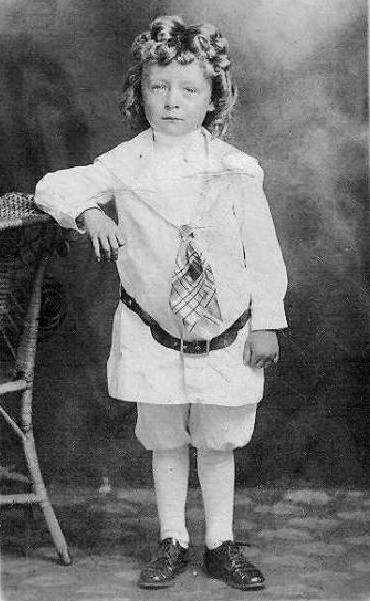
American Tunics: Individual Boys

Figure 1.--We have found large numbers of American photographs showing boys wearing tunics, especially in the early 20th century. Many of these images are undated and unidentified. We have developed some information about these images, even the ones that are unidentified. This portrait is undated, but was pribably taken about 1910.
|
|
Quite a bit of information is available on HBC about tunics. Many individual American boys are pictured wearing tunics. A substantial number of boys wearing tunics are archived on HBC, redlecting the importance of the style over time. We have only begun to link them here, but we will persue this project over time. We do not always, however, always know their names. Some are also not dated, but the dates can often be estimated. We will arrange the boys here chronolically which will help us understand chnging styles and conventions over time.
This American boy wears a mid-19th century tunic suit. The portrait is undated, but because it is an ambrotype it was probably taken about 1855-61. We would guess about 1860. Ambrotypes were still made in the early 1860s, but were very rapidly replaced by CDVs.
Quentin Roosevelt was perhaps the best known boy at the turn of the century in America and he wore a tunic suit about 1901. Quentin, the youngest child, was also born in Washington DC. Quentin was probably his father's favorite, as is often the case of the youngest. All of the Roosevelt boys enlisted in World War I. Quetin was killed as a fighter pilot in aerial combat over France. This great personal tragedy caused his father to rethink his attitude toward war in his later years.
Harold and Phyllis Fitzroy-Carrington were extensively photographed outside what is probably their home in New York in about 1904-15. A HBC contributor has a collection of nine albums of photographs that were taken by the childrens father, an enthusiastic amateur photographer. As a result, there are many charming images beside stiff, formal portraits. Their father was obviously a wealthy man. They had a New York City brick row house and they also had a country home called 'Mallowfield' at Mamaroneck. N.Y. There are approximately 100 photos in each album, many of them of Harold and his siblings playing with toys, pets, bikes etc some in swimming costumes, some playing musical instruments. The collection is a wonderful view of childhood in a wealthy NewYork family in the years before World War I. I believe that Harold was born about 1897 and Phyllis about 1900.
Many images illustrating historic boys clothes are soletary photographs, often anonamous images that do not show what the child wore when he was younger and older. A fascinating series of images from the forst few years of the 1900s are available for an Ohio boy, Lawrence Ivan Maicie. The photographs show what Lawrence wore from infanthood to about 10 yeas of age. His doting mother seems to have been particularly fond of tunics and large floppy bows. The sereies gives a good idea of the progression of styles for an American boy in the first decade of the 20th Century.
These two children survivied the Titantic disaster in 1912. Louis, the older boy, wears a tunic suit with loosely buttoned belt, striped knickers, white long stockings and hightop shoes with side buttons. He is holding a ball and looks to be about 4 or 5 years old. The younger child (Edmond?) wears a one-piece romper suit with self-belt, white long stockings, and ankle-strap shoes. Edmond looks no older than 2 or 3 years old. Notice that Edmond seems to be holding a model of a ship--possibly a small replica of the Titanic.
We notice James Jones from Springfield, Illinois wearing an emaculate white tunic suit in 1913. This formal portrait shows Lewis Overaker's mother, Clarissa Jones, at the age of 2 years, with her older brother James Jones, Lewis's uncle (aged 6). This photo was taken in 1913 in Springfield, Ill. The children are dressed for a formal studio portrait. The girl wears a white dress, white long stockings, white spats and black shoes. Her older brother wears a tunic suit done in the sailor style, but all white without stripes. The silor collar was ruffled. This was a popular style at the time, including the all-white outfits. The outfit has a white dickey and a black belt. With his tunic suit he wears matching white bloomer knickers and, white long stockings, and black button-spats over his black shoes. James hair is cut in bangs. Clarissa wearing an infant dress has a center part
Mother dressed all the Hubbard boys in different styles of sailor tunics. They ranged in age from about 3 to8 years in age. They wear them with bloomer knickers and long stockings. Two of the boys wear sandals. Theur father was a fruit and dairy farmer from Urbana, Illinois.
Stanley (Michigan, 1918)
Here a hand written inscription on the back reads: "Detroit Mich. 17 Gardoni My little boy Stanly when he was 7 years & one month taken March 30/1918." This looks to be a outfit Stanley may have worn to school.
HBC

Navigate the Boys' Historical Clothing hair style pages:
[Return to the Main long hair page]
[Return to the Main curl hair page]
[Bangs]
[Ringlet curls]
[Hair bows]
[Caps]
[Collar bows]
Navigate the Boys' Historical Clothing Web Site:
[Return to the Main American tunic page]
[Introduction]
[Activities]
[Biographies]
[Chronology]
[Clothing styles]
[Countries]
[Topics]
[Bibliographies]
[Contributions]
[FAQs]
[Glossaries]
[Images]
[Links]
[Registration]
[Tools]
[Boys' Clothing Home]
Created: 8:09 PM 9/27/2006
Last edited: 7:53 PM 12/11/2007



